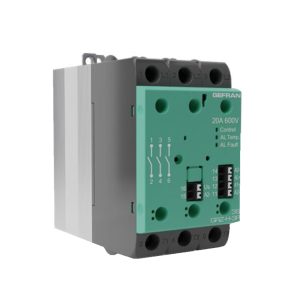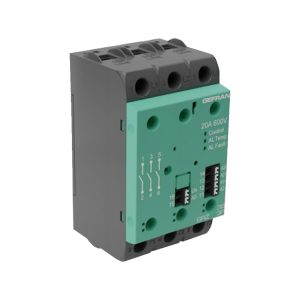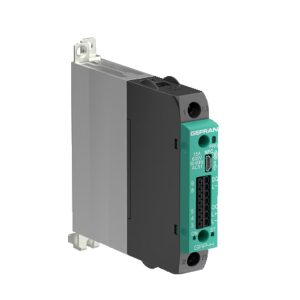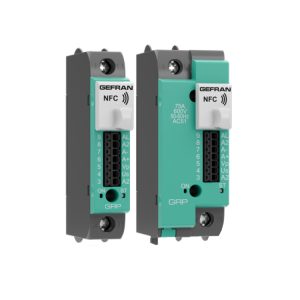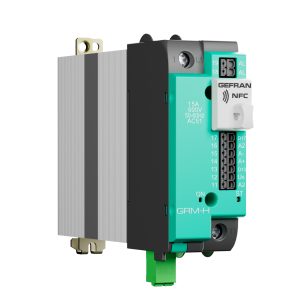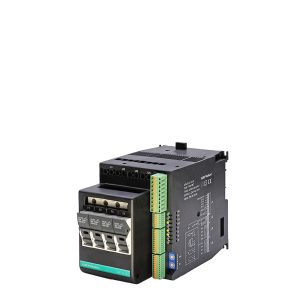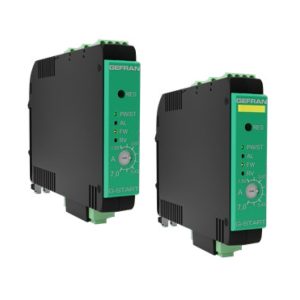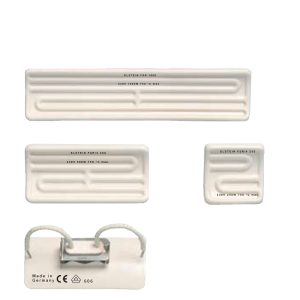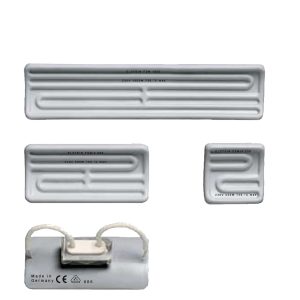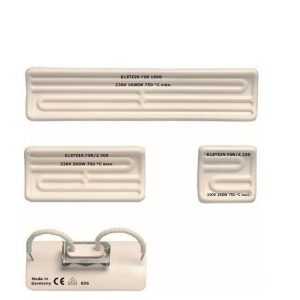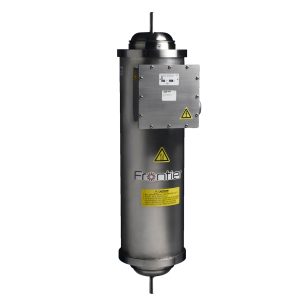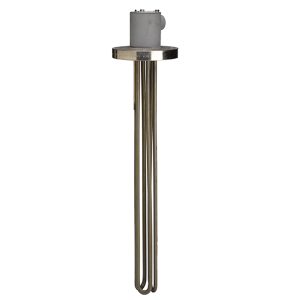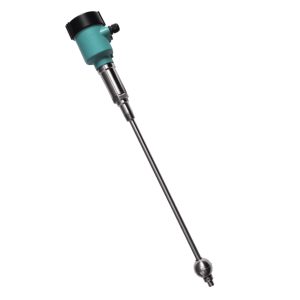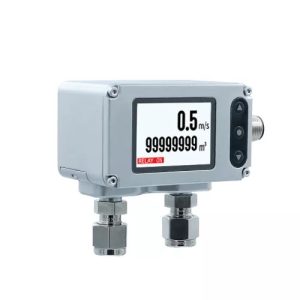- Zero-crossing voltage switching (ZC)
- Overtemperature protection
- Compact designs
-
 Features • Command input from analogue voltage or current signal or potentiometer. • Switching at voltage zero crossing. • Partialization of wave train power with dynamically optimized time cycle. • Antiparallel double SCR • 2 led for supply indication, “ON” state, 1 optional LED for load interrupt alarm • 4000V isolation between input circuit and power output • MOV (varistor) • Optional monitoring of interrupted load
Features • Command input from analogue voltage or current signal or potentiometer. • Switching at voltage zero crossing. • Partialization of wave train power with dynamically optimized time cycle. • Antiparallel double SCR • 2 led for supply indication, “ON” state, 1 optional LED for load interrupt alarm • 4000V isolation between input circuit and power output • MOV (varistor) • Optional monitoring of interrupted load -
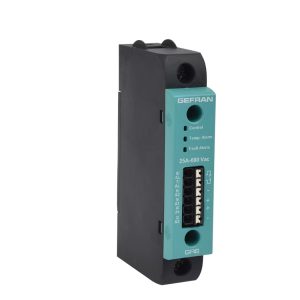 Features • Command input from analogue voltage or current signal or potentiometer. • Switching at voltage zero crossing. • Partialization of wave train power with dynamically optimized time cycle. • Antiparallel double SCR • 2 led for supply indication, “ON” state, 1 optional LED for load interrupt alarm • 4000V isolation between input circuit and power output • MOV (varistor) • Optional monitoring of interrupted load
Features • Command input from analogue voltage or current signal or potentiometer. • Switching at voltage zero crossing. • Partialization of wave train power with dynamically optimized time cycle. • Antiparallel double SCR • 2 led for supply indication, “ON” state, 1 optional LED for load interrupt alarm • 4000V isolation between input circuit and power output • MOV (varistor) • Optional monitoring of interrupted load -
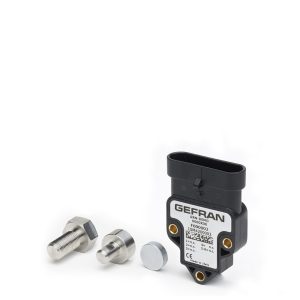 Features • Measurement range: ±180° - different values on request programmable in steps of ±15° (ONLY for analogue versions) • Supply voltage: +5Vdc (only for 0.5..4.5Vdc output); +9…+36Vdc (see output signal for right supply voltage) • Output signal: 0.5...4.5V RATIOMETRIC (supply +5Vdc); 0.5...4.5V; 0...10V; 4...20mA; CANopen, SAE J1939 • Electrical connections: AMP Superseal 6P 282108-1; cable output 18 AWG 1.65mm OD • Resolution and speed of rotation: 12 bit (analog output); 14 bit (CANopen/SAE J1939 output); 120 rpm max. • Linearity: < ±0.5%FS • Working and coefficient temperature: -40°C ... +85°C (higher values on request); thermal drift < 50 ppm/°C
Features • Measurement range: ±180° - different values on request programmable in steps of ±15° (ONLY for analogue versions) • Supply voltage: +5Vdc (only for 0.5..4.5Vdc output); +9…+36Vdc (see output signal for right supply voltage) • Output signal: 0.5...4.5V RATIOMETRIC (supply +5Vdc); 0.5...4.5V; 0...10V; 4...20mA; CANopen, SAE J1939 • Electrical connections: AMP Superseal 6P 282108-1; cable output 18 AWG 1.65mm OD • Resolution and speed of rotation: 12 bit (analog output); 14 bit (CANopen/SAE J1939 output); 120 rpm max. • Linearity: < ±0.5%FS • Working and coefficient temperature: -40°C ... +85°C (higher values on request); thermal drift < 50 ppm/°C -
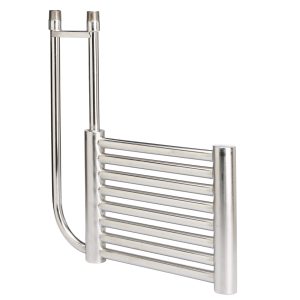 Features • Wide variety of materials available for use in heating or cooling applications for alkaline or acid solutions and rinse tanks. Check solution guide or consult with • your chemical supplier for proper sheath material. • Heavy wall, 20 gauge metal tubing available in steel, 316 stainless steel and titanium. • 1” diameter tubing and 1” MNPT connection fittings standard. • 4.6 square foot to 89.9 square foot of exchange area • Single point connections reduce the potential for leaks and simplify installation
Features • Wide variety of materials available for use in heating or cooling applications for alkaline or acid solutions and rinse tanks. Check solution guide or consult with • your chemical supplier for proper sheath material. • Heavy wall, 20 gauge metal tubing available in steel, 316 stainless steel and titanium. • 1” diameter tubing and 1” MNPT connection fittings standard. • 4.6 square foot to 89.9 square foot of exchange area • Single point connections reduce the potential for leaks and simplify installation -
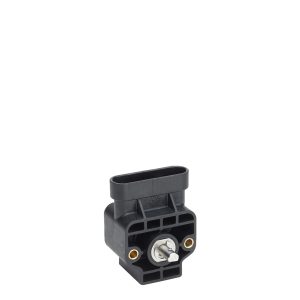 Features • Measurement range: ±180° different values on request programmable in steps of ±15° (ONLY for analogue versions) • Supply voltage: +5Vdc (only for 0.5..4.5Vdc output); +9…+36Vdc (see output signal for right supply voltage) • Output signal : 0.5...4.5V Ratiometric (supply +5Vdc); 0.5...4.5V; 0...10V; 4...20mA; CANopen, SAE J1939 • Electrical connections: AMP Superseal 6P 282108-1; DEUTSCH 6P DT04-6P • Resolution and speed of rotation: 12 bit (analog output); 14 bit (CANopen/SAE J1939 output); 120 rpm max. • Linearity: < ± 0.5% FS • Working and coefficient temperature: -40°C ... +85°C (higher values on request); thermal drift < 50 ppm/°C
Features • Measurement range: ±180° different values on request programmable in steps of ±15° (ONLY for analogue versions) • Supply voltage: +5Vdc (only for 0.5..4.5Vdc output); +9…+36Vdc (see output signal for right supply voltage) • Output signal : 0.5...4.5V Ratiometric (supply +5Vdc); 0.5...4.5V; 0...10V; 4...20mA; CANopen, SAE J1939 • Electrical connections: AMP Superseal 6P 282108-1; DEUTSCH 6P DT04-6P • Resolution and speed of rotation: 12 bit (analog output); 14 bit (CANopen/SAE J1939 output); 120 rpm max. • Linearity: < ± 0.5% FS • Working and coefficient temperature: -40°C ... +85°C (higher values on request); thermal drift < 50 ppm/°C -
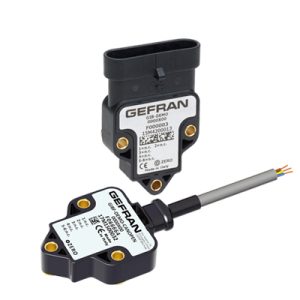 Features
Features- Measurement range : ±10° ±15° ±20° ±30° ±45° ±60° ±85° (dual axis XY); 360° (±180°) (single axis Z)
- Supply voltage: +5Vdc (only for 0.5..4.5Vdc output); +10…+36Vdc (see output signal for right supply voltage)
- Output signal: 0.5...4.5V RATIOMETRIC (supply +5Vdc); 0.5...4.5V; 0...10V; 4...20mA; CANopen
- Electrical connections: AMP Superseal 6P 282108-1; 6 wires output 18 AWG 1.65mm OD (cable+connector on request)
- Resolution: 0.05° (±10° to ±20°); 0.05°(±30°); 0.1°(±45°); 0.1°(±60°); 0.1°(±85°); 0.1° (±180°) analog output; 0.05° CANopen output
-
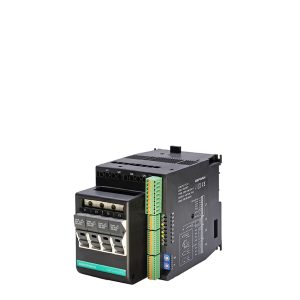 Features • Current sizes 16, 32, 40 Amps per channel • Integrated current transformers • Fuses with fuse-holder disconnectors on the front (option) • 4 universal process inputs ( TC, RTD, mA, V ) • 4 independent hot/cold PIDs • 4 main outputs (directly connected to the static unit) • 4 auxiliary analogue inputs (option) • 4 settable outputs (option): relay/logic/TRIAC/analogue • 2 settable relay outputs • 2 settable digital inputs • Modbus RTU communication port • Communication port for Fieldbus (option): Profinet, Profibus DP, Ethernet IP, EtherCAT, Modbus TCP/RTU, CANopen, DeviceNET • ODVA (Ethernet/IP) and PI (ProfiNET) certification • DIN rail or panel mounting • CE, UL, CSA certifications and SCCR UL 508 100KA approval
Features • Current sizes 16, 32, 40 Amps per channel • Integrated current transformers • Fuses with fuse-holder disconnectors on the front (option) • 4 universal process inputs ( TC, RTD, mA, V ) • 4 independent hot/cold PIDs • 4 main outputs (directly connected to the static unit) • 4 auxiliary analogue inputs (option) • 4 settable outputs (option): relay/logic/TRIAC/analogue • 2 settable relay outputs • 2 settable digital inputs • Modbus RTU communication port • Communication port for Fieldbus (option): Profinet, Profibus DP, Ethernet IP, EtherCAT, Modbus TCP/RTU, CANopen, DeviceNET • ODVA (Ethernet/IP) and PI (ProfiNET) certification • DIN rail or panel mounting • CE, UL, CSA certifications and SCCR UL 508 100KA approval -
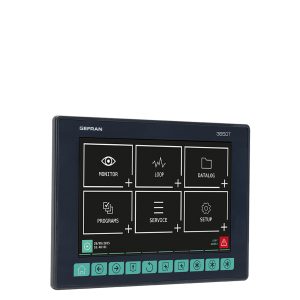 Features • Operator interface with color touch screen display, 7” • Up to 16 PID control loops • Cascade, ratio and valve PID controls • Profile programmer with ramps and retention; synchronous and asynchronous • Up to 250 Programs with 50 segments • 3 password protected user levels • Energy meter (kWh) • Configurable logic operations • Configurable math functions • Data Log with Real Time Clock • Batch Report management • Open format files (CSV) or encrypted for DataLog and production batches • Setting up custom pages • Active and historical alarm management • USB for data export and parameter cloning • Control parameter advanced tuning • Configurable analogue and digital I/O signals • HMI/SCADA/PLC data exchange via Ethernet Modbus TCP • Message language selection
Features • Operator interface with color touch screen display, 7” • Up to 16 PID control loops • Cascade, ratio and valve PID controls • Profile programmer with ramps and retention; synchronous and asynchronous • Up to 250 Programs with 50 segments • 3 password protected user levels • Energy meter (kWh) • Configurable logic operations • Configurable math functions • Data Log with Real Time Clock • Batch Report management • Open format files (CSV) or encrypted for DataLog and production batches • Setting up custom pages • Active and historical alarm management • USB for data export and parameter cloning • Control parameter advanced tuning • Configurable analogue and digital I/O signals • HMI/SCADA/PLC data exchange via Ethernet Modbus TCP • Message language selection -
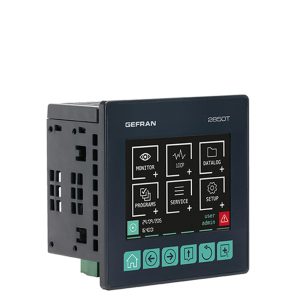 Features • Operator interface with color touch screen display, 3.5 “ • Up to 8 PID control loops • Cascade, ratio and valve PID controls • Profile programmer with ramps and retention; synchronous and asynchronous • Up to 200 Programs with 50 segments • 3 password protected user levels • Energy meter (kWh) • Configurable logic operations • Configurable math functions • Data Log with Real Time Clock • Batch Report management • Open format files (CSV) or encrypted for DataLog and production batches • Setting up custom pages • Management of active and historic alarms • Active and historical alarm management • USB for data export and parameter cloning • Control parameter advanced tuning • Configurable analogue and digital I/O signals • HMI/SCADA/PLC data exchange via Ethernet Modbus TCP • Message language selection
Features • Operator interface with color touch screen display, 3.5 “ • Up to 8 PID control loops • Cascade, ratio and valve PID controls • Profile programmer with ramps and retention; synchronous and asynchronous • Up to 200 Programs with 50 segments • 3 password protected user levels • Energy meter (kWh) • Configurable logic operations • Configurable math functions • Data Log with Real Time Clock • Batch Report management • Open format files (CSV) or encrypted for DataLog and production batches • Setting up custom pages • Management of active and historic alarms • Active and historical alarm management • USB for data export and parameter cloning • Control parameter advanced tuning • Configurable analogue and digital I/O signals • HMI/SCADA/PLC data exchange via Ethernet Modbus TCP • Message language selection -
 Features • Complete system for the simultaneous strain-measurement on up to four tie bars • Direct display of the measured values in µe, kN or t • Quick and easy non-destructive assembly • High accuracy and linearity in tension and pressure (like bonded strain gauges) • Ideal for use on presses, injection-moulding and die-casting machines • One system for many different tie bar diameters (25…400mm) • Dynamic applications • 4- channel digital monitor DU4D • USB connection for tie bar adjustment software (optional) • Analog output 0...10VDC (optional) • Very compact and easy to use system
Features • Complete system for the simultaneous strain-measurement on up to four tie bars • Direct display of the measured values in µe, kN or t • Quick and easy non-destructive assembly • High accuracy and linearity in tension and pressure (like bonded strain gauges) • Ideal for use on presses, injection-moulding and die-casting machines • One system for many different tie bar diameters (25…400mm) • Dynamic applications • 4- channel digital monitor DU4D • USB connection for tie bar adjustment software (optional) • Analog output 0...10VDC (optional) • Very compact and easy to use system -
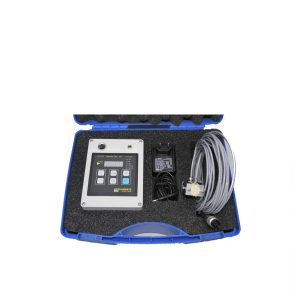 Features • Complete system for the strain-measurement on one tie bar • Direct display of the measured values in µe, kN or t • Quick and easy non-destructive assembly • High accuracy and linearity in tension and pressure (like bonded strain gauges) • Ideal for use on presses, injection-moulding and die-casting machines • One system for many different tie bar diameters (25…400mm) • Dynamic applications • 1- channel digital monitor DU1D • Ideal for self-construction load cells • Very compact and easy to use system
Features • Complete system for the strain-measurement on one tie bar • Direct display of the measured values in µe, kN or t • Quick and easy non-destructive assembly • High accuracy and linearity in tension and pressure (like bonded strain gauges) • Ideal for use on presses, injection-moulding and die-casting machines • One system for many different tie bar diameters (25…400mm) • Dynamic applications • 1- channel digital monitor DU1D • Ideal for self-construction load cells • Very compact and easy to use system -
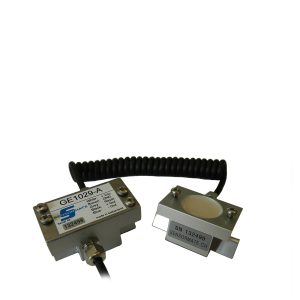 Features • Direct measurement of surface strain • With integrated digital amplifier • Quick and easy non-destructive assembly • High accuracy and linearity • Ideal for use on presses, injection-moulding and die-casting machines • One system for many different tie bar diameters (25…250mm) • Dynamic applications • Ideal for online monitoring of clamping force
Features • Direct measurement of surface strain • With integrated digital amplifier • Quick and easy non-destructive assembly • High accuracy and linearity • Ideal for use on presses, injection-moulding and die-casting machines • One system for many different tie bar diameters (25…250mm) • Dynamic applications • Ideal for online monitoring of clamping force -
 Features • Direct measurement of surface strain • Quick and easy non-destructive assembly • High accuracy and linearity in tension and pressure (like bonded strain gauges) • Ideal for use on presses, injection-moulding and die-casting machines • One system for many different tie bar diameters (25…400mm) • Dynamic applications • Without amplifier (passive) • Ideal for online monitoring of clamping force • Ideal for self-made load cells
Features • Direct measurement of surface strain • Quick and easy non-destructive assembly • High accuracy and linearity in tension and pressure (like bonded strain gauges) • Ideal for use on presses, injection-moulding and die-casting machines • One system for many different tie bar diameters (25…400mm) • Dynamic applications • Without amplifier (passive) • Ideal for online monitoring of clamping force • Ideal for self-made load cells -
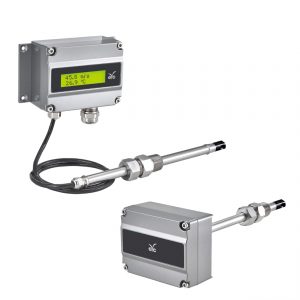 Features
Features- IP rating:IP67, rugged aluminum case, fit in variety harsh environment
- Capable of temperature compensation
- Linear calibration air velocity by computer, analog output or RS-485(Optional)
- High-speed, high-accuracy measurement, quickly respond
- Thermal mass flow sensor
- LCD, display air velocity and temperature
- Switch multifunction physical quantities:[m/s]、[ft/s]、[km/h]、[mph]、[kont]
- DIP SWITCH and RS-485 function
- Follow customer needs to plan measuring range, analog output, stations, and zero-point OFF SET or
- RS-485 adjustment zero-point OFF SET
- Free programmable software : Data logger / Maximum record 65535 data / Chart
-
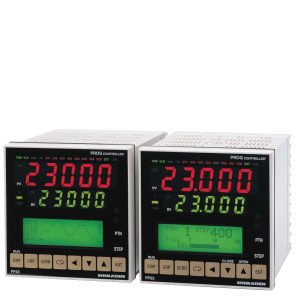 Features • 2-channel controller (Basic type: 1-channel controller) • Independent 2-loop / 2-input operation control • High accuracy ± (0.1% FS + 1 digit) • High Sampling Cycle 0.1 sec. • High resolution 1/ 1000 °C display achieved *Only for R.T.D. input (scale: 0.000~30.000 °C) • Programmable Max. 400 steps (400 steps x 1 pattern to 20 steps x 20 patterns) • Auto-Tuning PID / Expert PID • Max. 10 Zone PID control available • Independent Universal-Input • User Friendly Operation (Menu Driven: 4 Lines LCD Display) • Easy Setting & Maintenance via Infrared COM port on the front panel • Interface RS-232C/RS-485 (MODBUS / Shimaden) • The front dust/splash-proof IP66 • Universal Power Supply (100~240V AC ±10%) • Sensor power supply
Features • 2-channel controller (Basic type: 1-channel controller) • Independent 2-loop / 2-input operation control • High accuracy ± (0.1% FS + 1 digit) • High Sampling Cycle 0.1 sec. • High resolution 1/ 1000 °C display achieved *Only for R.T.D. input (scale: 0.000~30.000 °C) • Programmable Max. 400 steps (400 steps x 1 pattern to 20 steps x 20 patterns) • Auto-Tuning PID / Expert PID • Max. 10 Zone PID control available • Independent Universal-Input • User Friendly Operation (Menu Driven: 4 Lines LCD Display) • Easy Setting & Maintenance via Infrared COM port on the front panel • Interface RS-232C/RS-485 (MODBUS / Shimaden) • The front dust/splash-proof IP66 • Universal Power Supply (100~240V AC ±10%) • Sensor power supply -
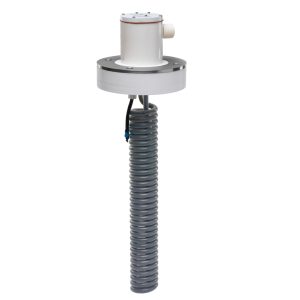 Features • Inert to most aqueous acid, alkaline, anodizing, & pickling solutions up to 100°C (212°F) • Rugged, heavy wall PTFE covered stainless steel element and PVDF screw plug reduces permeation. Guaranteed 100% pinhole free • Space saving & long service life with low Watt density design of 10 W/in2 (1.5 W/cm2) • Polypropylene terminal enclosure with 3 ft (.9m) flexible PVC liquid tight conduit • Lower Watt densities available for highly viscous solutions & technical acids
Features • Inert to most aqueous acid, alkaline, anodizing, & pickling solutions up to 100°C (212°F) • Rugged, heavy wall PTFE covered stainless steel element and PVDF screw plug reduces permeation. Guaranteed 100% pinhole free • Space saving & long service life with low Watt density design of 10 W/in2 (1.5 W/cm2) • Polypropylene terminal enclosure with 3 ft (.9m) flexible PVC liquid tight conduit • Lower Watt densities available for highly viscous solutions & technical acids -
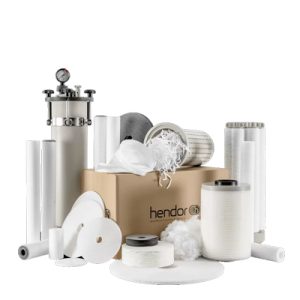 Filter media are used for filter pumps and filter chambers. We provide filter bags, filter discs, filter cartridges, and micro fibers. [ Click here for more details ]
Filter media are used for filter pumps and filter chambers. We provide filter bags, filter discs, filter cartridges, and micro fibers. [ Click here for more details ] -
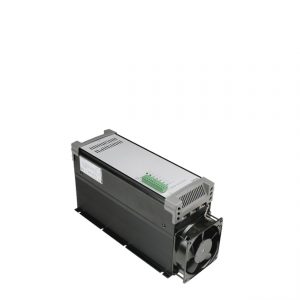 Features
Features- Independent adjustment of Max and BIAS.
- Down-opened Panel, easy for fuse replacement.
- VR of Max and SFS are installed in the front panel, easy for adjustment.
- Multi-LED display panel makes the operating condition clear.
- The auxiliary powers (AC1, AC2) are independently controlled for all models.
- Build-in buffering output adjustment (SFS VR), adjusting range 1~22 seconds. (Only for the phase control product)
- Top & bottom shielding covers are designed for safety and fashion out looking, also easy for wiring installation.
- In case of 0.5 Hz sudden power losses, system output can be switched off immediately. Once the power is restored, the system will buffer the output to prevent the voltage surge for fuse burn-down

